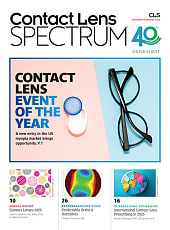business builders
Managed Care Conundrum
by Brad Childs
The old fee-for-service mentality is a thing of the past. Every retail optical business, regardless of size, is affected by managed care.
Many potential customers walk into a location, and even before they begin to look around will ask, "Do you take my insurance?" At this question, the once potentially profitable patron often becomes viewed as the dreaded customer with health care benefits.
The reality is that third-party is here to stay. Yet everyone likes to blame someone for a loss in revenues, so why not point the finger at third-party?
The ratio of private-pay to third-party business varies greatly. Some businesses report that 75 percent of transactions are third-party. Others, like Lloyd Yazbek, CEO of Central Optical in Youngstown, Ohio, say the vast majority of his lab's jobs are still private-pay. "Too much emphasis is put on the negative," he says. "Although insurance has a place in our industry and is not going away, it is no way close to being the primary revenue generator in many businesses. Third-party reflects under a quarter of what I do."
| Let's Role Play |
|---|
| Here's how we handle managed care customers at Eyetique. STEP 1: A client enters the store, and would like to look for some new glasses. However, they ask the inevitable, "Do you take my insurance?" STEP 2: Assuming that we do, we welcome them and treat them exactly as if they were a full-pay client. STEP 3: We discuss briefly that their coverage is fantastic. This is a great opportunity to begin to plant the seed about multiple pairs and better lenses with better coatings. STEP 4: Then, as if they are a full-pay client, we show them around, creating a story about all of the fantastic designers we have. STEP 5: Throughout their experience, there is no difference to us if they are insured or not. Period. |
MARKETING MUSCLE
When it comes to driving people through the door, there is no way a small optical business could possibly compete with the marketing muscle of big insurers like Davis Vision, Vision Service Plan, EyeMed, VSP, and Vision Benefits of America. Take advantage of those dollars spent, and view them as yet another way to draw in consumers.
As Rob Lynch, president and CEO of VSP, describes the firm's first-ever TV ad: "TV brings our message to life in sight and sound. [It] is a great way to reach people—a lot of people—in a pretty short time. What better way to help folks get to know who we are and what we do. Our new ads clearly bring home the point that ‘Words can't describe what your eyes bring to life.’"
Whatever their message, solid third-party programs are likely to bring you more prospective patients and customers than all your own advertising combined.
ALL ABOUT NUMBERS
Are you getting paid enough from the insurance companies for the work you are providing? It all depends on how you look at it.
For example, under third-party, the returns for a comprehensive eye exam are not great. That's obvious. You were collecting a solid $70 to $130 for each exam, and now your return may be cut by half or more.
However, you are reaching a far wider spectrum of people who will not consider going to you if you don't take their insurance. Plus, every examination is an opportunity for the doctor to begin the sale in the chair by making professional recommendations based on their findings.
Third-party insurances also promote regular eye examinations. The more frequently patients walk through your doors, the more opportunities you have to present them product.
Michael Gissin, president of Vision Benefits of America, says: "Managed eyecare is the number-one driving force in promoting a routine eye exam and subsequent services to the doctor's office and retail eye locations. A routine eye exam is a beginning look at a person's overall health. The first signs of diabetes and high blood pressure are often detected at the OD's office."
THE NEED TO EMBRACE
We need to be able to understand how managed care optical plans work, and capitalize on each client who walks through our doors, whether they have insurance or not. How? By selling from the top down.
■ Show the most expensive frames first.
■ Engage your client in conversation, and show lifestyle frames.
■ Talk only about the best lenses and finest coatings.
■ Worry about insurance last. It is irrelevant how the client is going to pay for their product, because most insurance programs will allow better coatings, better lenses, etc. They support upselling.
Managed care gets the patient in the door. The rest is up to you. EB
Brad Childs is an optician as well as vice president and COO of Eyetique, with six high-end locations in the Pittsburgh area.



